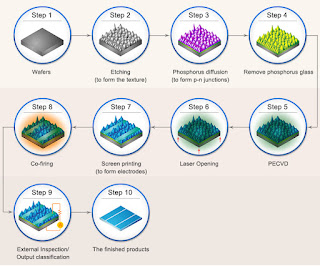Types off panels
Monocrystalline cells are cut from a single crystal of silicon- they are effectively a slice from a crystal.
In appearance, it will have a smooth texture and you will be able to see the thickness of the slice.
These are the most efficient and the most expensive to produce. They are also rigid and must be mounted in a rigid frame to protect them.
In appearance, it will have a smooth texture and you will be able to see the thickness of the slice.
These are the most efficient and the most expensive to produce. They are also rigid and must be mounted in a rigid frame to protect them.

Polycrystalline (or Multicrystalline) cells are effectively a slice cut from a block of silicon, consisting of a large number of crystals.
They have a speckled reflective appearance and again you can you see the thickness of the slice.
These cells are slightly less efficient and slightly less expensive than monocrystalline cells and again need to be mounted in a rigid frame.
They have a speckled reflective appearance and again you can you see the thickness of the slice.
These cells are slightly less efficient and slightly less expensive than monocrystalline cells and again need to be mounted in a rigid frame.

Amorphous cells are munufactured by placing a thin film of amorphous (non crystalline) silicon onto a wide choice of surfaces. These are the least effient and least expensive to produce of the three types. Due to the amorphous nature of the thin layer, it is flexible, and if manufactured on a flexible surface, the whole solar panel can be flexible.
One characteristic of amorphous solar cels is that their power output reduces over time, particularly during the first few months, after which time they are basically stable. The quoted output of an amorphous panel should be that produced after this stabalisation.
One characteristic of amorphous solar cels is that their power output reduces over time, particularly during the first few months, after which time they are basically stable. The quoted output of an amorphous panel should be that produced after this stabalisation.


Comments
Post a Comment